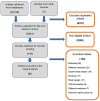Obesity as a predictive factor for chronic kidney disease in adults: systematic review and meta-analysis
- PMID: 33656052
- PMCID: PMC7917711
- DOI: 10.1590/1414-431X202010022
Obesity as a predictive factor for chronic kidney disease in adults: systematic review and meta-analysis
Abstract
Chronic kidney disease (CKD) is one of the main chronic diseases affecting the world population due to its high prevalence and increasing morbidity. Similarly, obesity gained the interest of the scientific community as it directly or indirectly increases mortality from cardiovascular causes, and its prevalence characterizes a pandemic. The objective of this study was to investigate obesity measured by body mass index as a predictor for end-stage renal disease in the general adult population. A systematic review and meta-analysis was carried out by searching 10 databases for prospective or retrospective cohort studies, with no restrictions on the language of publication, including adults with obesity without previous renal disease and who evolved to CKD (diagnosed by estimated glomerular filtration rate below 60 mL&mac_middot;min-1&mac_middot;(1.73 m2)-1 over the follow-up period. The R software and Meta package were used for data analysis. After removing duplicates, 5431 studies were submitted to the steps of the systematic review, and 21 articles were included in the data analysis. In total, 3,504,303 patients, 521,216 with obesity, and an average follow-up time of 9.86 years were included. The relative risk of obese people for developing CKD in the random effects model was 1.81 (95%CI: 1.52-2.16). The evidence found in this meta-analysis confirmed that obese people are at higher risk of developing CKD that the non-obese population (1.81 times higher), with obesity being a priority risk factor in preventive actions.
Figures






Similar articles
-
Prevalence of chronic kidney disease in Jing adults in China: a village-based study.Clin Nephrol. 2013 Jan;79(1):50-6. doi: 10.5414/CN107511. Clin Nephrol. 2013. PMID: 22948117
-
Association Between Obesity and Chronic Kidney Disease, Defined by Both Glomerular Filtration Rate and Albuminuria, in Korean Adults.Metab Syndr Relat Disord. 2017 Oct;15(8):416-422. doi: 10.1089/met.2017.0053. Epub 2017 Aug 23. Metab Syndr Relat Disord. 2017. PMID: 28832275
-
Effect of Different Obesity Phenotypes on Incidence of Chronic Kidney Disease in Tehranian Adults.J Am Coll Nutr. 2016 Sep-Oct;35(7):587-596. doi: 10.1080/07315724.2015.1046195. Epub 2015 Dec 9. J Am Coll Nutr. 2016. PMID: 26650689
-
Prevalence of chronic kidney disease in Bangladesh: a systematic review and meta-analysis.Int Urol Nephrol. 2021 Apr;53(4):713-718. doi: 10.1007/s11255-020-02597-6. Epub 2020 Aug 12. Int Urol Nephrol. 2021. PMID: 32789568
-
Blockbuster Medications for Obesity: A Primer for Nephrologists.Am J Kidney Dis. 2023 Dec;82(6):762-771. doi: 10.1053/j.ajkd.2023.04.009. Epub 2023 Jul 25. Am J Kidney Dis. 2023. PMID: 37500048 Review.
Cited by
-
Potential Therapeutic Exploitation of G Protein-Coupled Receptor 120 (GPR120/FFAR4) Signaling in Obesity-Related Metabolic Disorders.Int J Mol Sci. 2025 Mar 11;26(6):2501. doi: 10.3390/ijms26062501. Int J Mol Sci. 2025. PMID: 40141148 Free PMC article. Review.
-
The risk of herpes zoster is positively associated with obesity, especially morbid obesity.Sci Rep. 2024 Jun 21;14(1):14330. doi: 10.1038/s41598-024-65195-x. Sci Rep. 2024. PMID: 38906945 Free PMC article.
-
Exploring Adiposity and Chronic Kidney Disease: Clinical Implications, Management Strategies, Prognostic Considerations.Medicina (Kaunas). 2024 Oct 11;60(10):1668. doi: 10.3390/medicina60101668. Medicina (Kaunas). 2024. PMID: 39459455 Free PMC article. Review.
-
The Effect of Metabolic Syndrome and Its Individual Components on Renal Function: A Meta-Analysis.J Clin Med. 2023 Feb 17;12(4):1614. doi: 10.3390/jcm12041614. J Clin Med. 2023. PMID: 36836149 Free PMC article. Review.
-
Prevalence and associations of chronic kidney disease among antiretroviral therapy-naïve persons living with HIV in Lagos, Nigeria.BMC Nephrol. 2024 Aug 23;25(1):270. doi: 10.1186/s12882-024-03711-x. BMC Nephrol. 2024. PMID: 39179963 Free PMC article.
References
-
- Brasil . Sociedade Brasileira de Nefrologia: Censo de diálise SBN 2018. 2019. http://www.censo-sbn.org.br/censosanteriores.Accessed May 28 2019.
-
- ABESO (Associação Brasileira para o Estudo da Obesidade e da Síndrome Metabólica) Diretrizes Brasileiras de Obesidade 2016. São Paulo:: ABESO; 2016.
-
- WHO (World Health Organization) Obesity: preventing and managing the global epidemic: report of a WHO consultation. Geneva:: World Health Organization; 1999. - PubMed
Publication types
MeSH terms
LinkOut - more resources
Full Text Sources
Other Literature Sources
Medical
Miscellaneous

